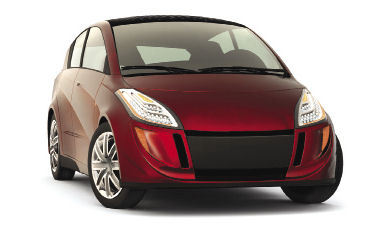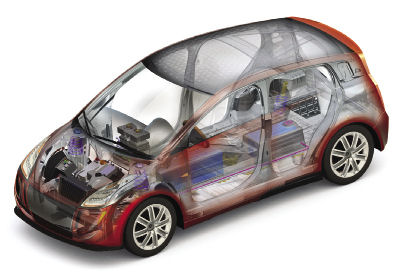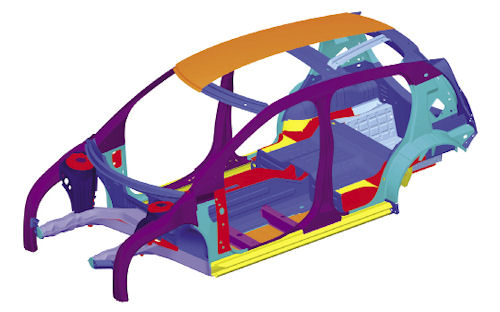Latest News
September 1, 2013
About nine years ago, Engineering Technology Associates was engaged by the Auto/Steel Partnership, a consortium of North American steel companies and automotive manufacturers.
 FutureSteelVehicle uses design optimization methodology, coupled with an expanded portfolio of high-strength and advanced high-strength steels and an array of steel technologies, to achieve a 39% mass savings in a battery electric vehicle. Images courtesy of Dr. Akbar Farahani, ETA. |
“They were trying to increase the use of advanced high-strength steel,” recalls Akbar Farahani, Ph.D., vice president of global engineering for the Troy, MI-based ETA. “We did several projects for them, doing weight reduction using optimization technology and software—sometimes reducing the gauge of the product and changing from mild steel to advanced high-strength steel.”
This simultaneously improved crashworthiness and durability, he says.
Those projects got Farahani thinking about ways to be more efficient on weight and mass reduction, ways to organize the whole product development cycle differently. He says: “I thought, ‘How can we have a holistic view of product design and development, from the beginning to the end?’”
The result was an optimization methodology he dubbed the Accelerated Concept to Product Process (ACP). ACP uses a holistic approach with multiple CAE tools to reduce product development time and costs, as well as to reduce product mass and improve product performance.
Last Things First
“The normal way to design,” says Farahani, “is that we have a structure and we try to fit that structure to our requirements. I’m changing the statement of the problem: What are the requirements—for crash safety, for durability, for noise, for vibration, for vehicle ride and handling? I want to put that at the front of the process, then design the vehicle based on those requirements.”
ACP also brings potential building materials and manufacturing requirements into the process at the very beginning, when the project is still at the concept stage.
“ACP looks at the concept from its inception,” says Farahani, “before you put any type of structure or shape to it. Based on your goals and targets, on your materials and manufacturing requirements, the ACP system creates structures that meet your requirements.
“The system will define the best material for the best location for the best performance,” he adds, noting that material might be steel, aluminum or carbon fiber composites in any combination.
Low-fidelity Design
Using topology optimization, ACP creates a low-fidelity design of your structure. “This low-fidelity design has the main structures and the materials and the material grades,” says Farahani. “It is going to give you the general sizes and shapes of the components.”
It does not include, however, styling considerations or design details, such as the radii on access holes. “We turn it over to the design engineers to design the way the car looks,” Farahani says.
Because that optimization automates so much of the low-level design work, ACP requires only about half as many design engineers as a traditional design process. “But they are always involved in the whole process,” Farahani points out. “The ACP process is like a search engine. It cannot create; it just finds the best solution within the design space provided. The design engineer is the one who is creating the design space. We humans have to tell the optimization where to go and where not to go.”
The final phase—design for manufacturing—uses 3D optimization for the manufacturing process. The result of all this optimization is a very efficient structure.
FutureSteelVehicle
In 2010, ETA was approached by WorldAutoSteel, the automotive group of the World Steel Association, about development of a concept vehicle, dubbed the Future-SteelVehicle (FSV).
“They wanted to do a concept vehicle, using the 2010 Volkswagen Polo as a baseline,” says Farahani. “They said, ‘We want to compete with this vehicle. How can we reduce the mass using advanced high-strength steel technology?’ WorldAutoSteel provided all the technology they had available for this vehicle; we applied ACP.”
Because this was the FutureSteelVehicle, Farahani adds, the materials under consideration were mainly various grades of steel—especially advanced, high-strength steels.
Reducing the Gauge
“Putting the right material, with the right strength, in the right location, is the key,” says Farahani. “Advanced high-strength steel costs more and may be difficult to manufacture, but the FSV uses this advanced high-strength steel in locations where we need a lot of strength for, say, crashworthiness.”
 This image shows FSV styling, body structure and powertrain layout in a “peel away” format. |
The standard way to increase the strength of steel parts, says Farahani, is through use of higher gauges of steel. This, unfortunately, adds weight. Rather than thicker steel, the FSV uses stronger steel. “We find where the critical load paths are,” says Farahani, “and then use the right strength of steel—as thin as is possible.”
A normal vehicle design uses plenty of 1 to 2mm gauge steel. Where strength is required for crashworthiness, it can be 2.5mm or thicker.
“The highest gauge of steel that we use in FSV is about 0.9mm,” says Farahani. “Usually it is very, very thin. We can get all the strength that is required, but more efficiently and with less mass.”
Saving Weight and Cost
“We created a vehicle that provided a 39% mass reduction, compared to the VW Polo baseline vehicle,” says Farahani. “We reduced more than 100 kg of the mass of this vehicle body structure.”
 FSV uses 97% high-strength and advanced high-strength steels, of which nearly 50% reach into GigaPascal strengths. |
That’s an impressive reduction in weight, yes, but how much does it cost?
“We did a cost analysis for FSV,” says Farahani. “The interesting thing is you spend more money on advanced high-strength steel—but because we use a lot less material, we basically break even. At the end of the day, there’s no cost to it.”
The Future is Now
As its name implies, the FutureSteelVehicle was designed for the future. “This vehicle was designed for 2015-2020,” Farahani says. “Some of the manufacturing technologies were pushing the envelope, but in the last four years that I’ve been involved with the FSV, I’ve seen a lot of those technologies in current production vehicles. I see Ford and GM using these technologies quite a bit in their products.
“They caught up very, very quickly. It surprised us.”
Contributing Editor Mark Clarkson is DE’s expert in visualization, computer animation, and graphics. His newest book is Photoshop Elements by Example. Visit him on the web at MarkClarkson.com or send e-mail about this article to [email protected].
More Info
American Iron & Steel Institute
Subscribe to our FREE magazine, FREE email newsletters or both!
Latest News
About the Author
Mark ClarksonContributing Editor Mark Clarkson is Digital Engineering’s expert in visualization, computer animation, and graphics. His newest book is Photoshop Elements by Example. Visit him on the web at MarkClarkson.com or send e-mail about this article to [email protected].
Follow DE





